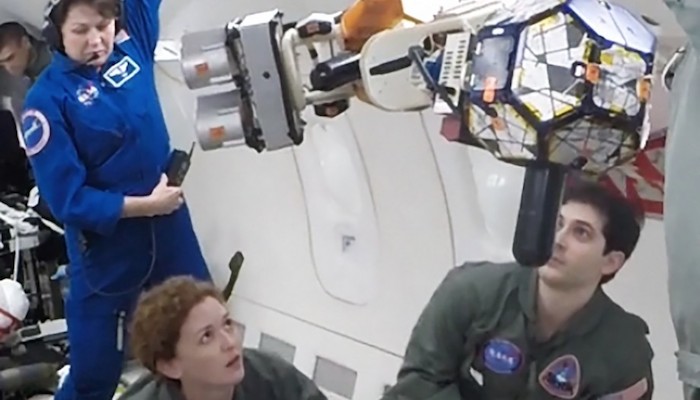.

Michele Carpenter and other researchers test the gyroscopes in microgravity flight.
.
Spoiler alert: In the closing scenes of “The Martian,” as the space shuttle she commands approaches Mars, Jessica Chastain’s character straps on a spacesuit and jetpack and scoots off into empty space to make a key rescue that will save the day.
Perhaps not a surprise to viewers, a jetpack like hers doesn’t quite exist, according to space engineers at the nonprofit Cambridge research facility Draper. But that team is working with MIT and the NASA Johnson Space Center to build better and more stable jetpacks that will allow astronauts to maneuver with purpose and ease.
Without gravity holding you down, making repairs outside the International Space Station comes with a unique set of challenges that you wouldn’t encounters while, say, fixing your roof. For one, it’s hard to make deliberate, precise movement because the body experiences an equal and opposite force that pushes you away and sends you spinning every time you reach out to grab something or try to hammer something down.
For this reason, astronauts that make repairs on the ISS are strapped to a robotic arm or are tethered to the space lab when they’re outside, gripping onto strategically placed handholds that keep them in position as they make their fix.
A new kind of jetpack that Draper researchers are building will combine “control momentum gyroscopes” with thrusters to help wearers keep both their orientation and their position when they’re trying to drill into an asteroid to extract a sample – something that NASA intends to do en route to a Mars trip by 2030.
NASA has used jetpacks of a sort before. The Manned Maneuvering Unit was tested by astronauts in 1984, but the technology was retired. The goal of the Draper-built tech is to allow the wearers to make more precise movements.
“The thrusters are going to keep you from moving away. The [gyroscopes] are to keep you from tumbling uncontrollably,” said Michele Carpenter, an engineer at Draper who designed the system.
A version of this technology is used to orient satellites, but those devices are big. “They’re not of a size that you can wear on your back or on your spacesuit,”Carpenter said.
The team has tested the technology in a virtual reality simulator, where astronauts were challenged to tackle a Martian landscape obstacle course dotted with orange pylons while wearing jetpacks. The team also tested the gyroscope technology in microgravity flights.
Quelle: The Boston Globe
4482 Views
